6 Major Marathons For Your Bucket List: Your Guide To Becoming A Six Star Finisher
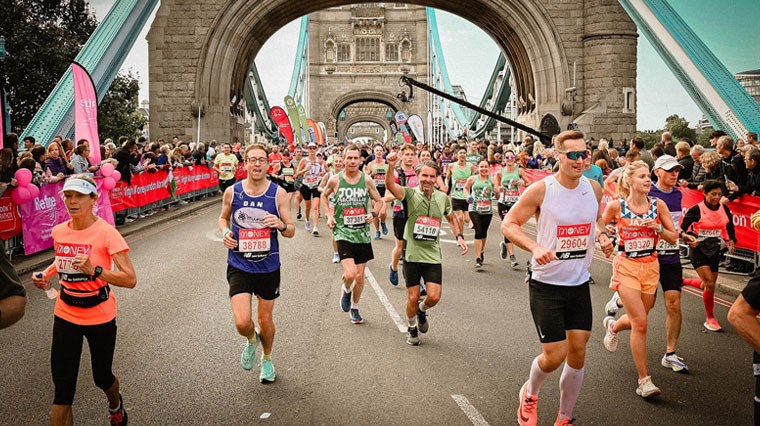
No matter if you’re an elite athlete or recreational runner, running a marathon is a memorable and life-changing experience – proving you can achieve your running goals and break perceived boundaries.
It’s not a secret – running a marathon is hard work, not only on race day but in fuelling your motivation to stay on track of your training in the months leading up to the starting line.
However, when weighing this up with the positive benefits of running on your mental health and physical wellbeing, there is nothing quite like it. Marathon training allows your body to adapt to breathe better on your runs, pace yourself and move more energy efficiently. Marathon racing builds grit, determination and positive self-esteem.
If you’ve achieved your goal of running a marathon - an epic 42.2km distance - you may have caught marathon fever in the buzz of the excitement and are asking yourself, now what? This certainly doesn’t have to be the end of your journey.
You can join the ranks of the thousands of celebrated runners that have achieved a Six Star Finisher Medal. Introduced in 2016 at the Tokyo Marathon, the title of Six Star Finisher is awarded to any runner that has completed all six of the must-run marathons across the globe as part of the Abbott World Marathon Majors; Tokyo Marathon, Boston Marathon, London Marathon, Berlin Marathon, Chicago Marathon and New York City Marathon.
You could be part of the legacy these prestigious marathons represent - that have been recognised for their ongoing sustainability, mass participation and organisation, among other criteria.
Besides completing each marathon in the designated cut off time, there’s no rush on it. No time frame is provided to receive a Six Star Finisher Medal in terms of the years it takes to tick these major marathons off your bucket list. The goal is to officially get across the finish line in each big race – and of course, to have fun!
To give you inspiration and insight to set you up for marathon success, Sportitude Running has done a breakdown of each major marathon to give you an idea of what to expect.
Tokyo Marathon
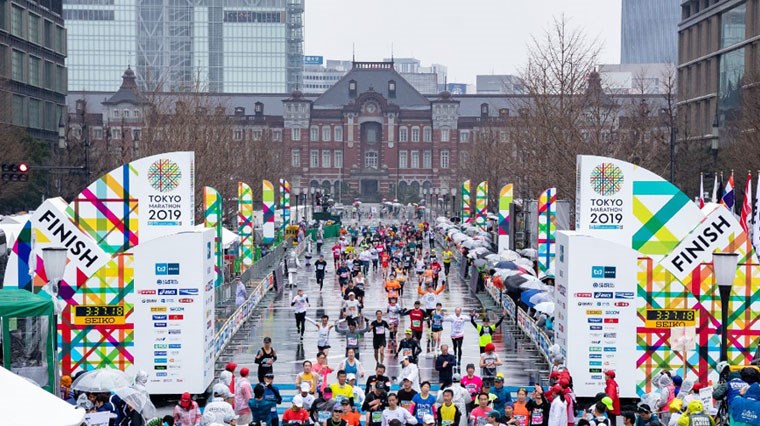
When is the Tokyo Marathon?
First Sunday of March (3rd of March, 2024).
About the Tokyo Marathon
The Tokyo Marathon is the newest to the Six Star line-up and beats all other marathons in Asia in terms of size. Since its origins in 2007, the Tokyo Marathon has become among the most sought out races in the world for both Japanese runners and tourists, with running being the most popular and celebrated sport in the country. The Tokyo Marathon brings together both elite runners and new marathoners - encouraging mass participation and a shared experience.
Why you’ll love the Tokyo Marathon
Tokyo is celebrated for its technology, cuisine and culture and walking through the futuristic city is an immersive and enlightening experience. What may be even more intriguing is the smooth fusion of the contemporary and traditional, with Tokyo’s historic shrines and cherished traditions embedded within the city.
The Tokyo Marathon has been praised as the best of the six major marathons in terms of its outstanding organisation, and it isn’t short of friendly volunteers which are available in the thousands to provide guidance and cheer you on with their vibrant energy, enthusiasm and the endearing nature of the locals. Whether you’re at the front or back of the pack, the success of every runner is celebrated.
What to expect from the Tokyo Marathon course
If you aren’t a fan of uphill running, the Tokyo Marathon is potentially a favourite on your bucket list. Besides some minor bridges and hills, it’s extremely flat – making it the ideal course if you're keen to set a new marathon PB and maintain a snappier pace, without any serious climbs to slow down your momentum.
The route weaves through Tokyo in a celebration of the breathtaking city’s past, present and future, kicking off at Shinjuku's Tokyo Metropolitan Government Building, journeying through major districts like Nihonbashi, Asakusa, Ginza and Shinagawa and concluding at Tokyo Station. Along the way you'll soak in the sights on-the-run including highlights like the Imperial Palace.
The course includes 180 degree turns (‘out and back’), essentially backtracking to mirror the way you came, but with the benefit of putting faster runners in sight to inspire and motivate you.
Application process
Out of the hundreds of thousands of registrations, only about 38,000 are accepted in the Tokyo Marathon. Applicants are randomly drawn, so getting to the point where you’re lining up for the starting line takes not only grit and determination, but pure luck.
August of each year is when applications open, and you should find out by late November whether you’ve essentially won the ‘marathon lotto’ and have secured yourself a place. Anyone participating in the marathon must be 19 years old or up on race day.
For a guaranteed place in the Tokyo marathon, you can apply to be a charity runner. There are limited places for charity runners (maximum 4,000) and a minimum donation is required (typically starting at ¥100,000 - about $1085 AUD). Be aware not all of the official charity organisations allow international applications and there is a minimum time allocated to raise funds.
If you're a veteran marathoner, you may be able to be considered as a Run As One (Semi-Elite) entry. However, places are seriously limited (25 male runners and 25 female runners for international athletes) and you must meet the qualifying times specified in a World Athletics Label, World Athletics Elite Label, or World Athletics Elite Platinum Label event.
Tokyo Marathon: Need-to-know
The weather can be unpredictable at this time of year in Japan, and to be on the safe side you should expect chill and rain. Don’t let that stop you – gear up in layers including a weather-resistant running jacket and run on. On the bright side, cooler weather will help prevent overheating when the road challenges you.
Boston Marathon
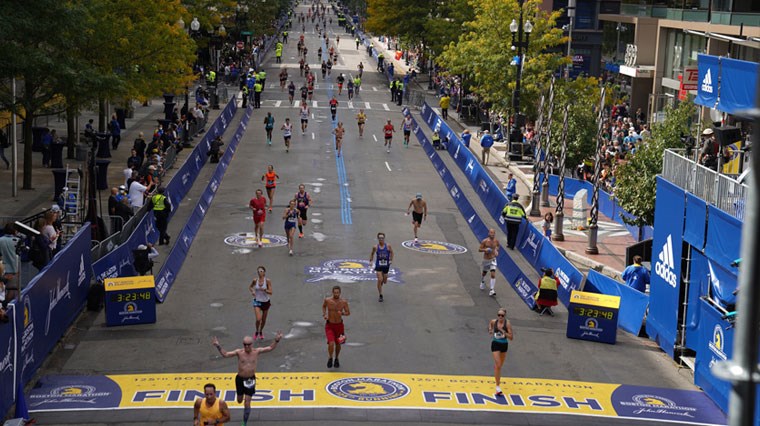
When is the Boston Marathon?
Third Monday of April, Patriots' Day (15th of April, 2024)
About the Boston Marathon
The Boston Marathon has a unique vibe and vibrant history, being the oldest annual marathon with the very first held in April 1897, over a century ago.
The 1967 Boston Marathon was a limit-defying event – when Katherine Switzer broke barriers to be one of the first women to complete a major marathon purely for the love of running – despite women not being officially allowed to race and her being nearly physically dragged off the course.
The Boston Marathon traditionally takes place on Patriots’ Day. It's a holiday celebrated in Massachusetts and Maine that honours the significance of the Battle of Lexington and Concord to American history, being the first battle of the American Revolution as they broke their ties with Britain.
Why you'll love the Boston Marathon
Boston itself has the charming vibe of a small town, fused into a modern city. Its bold history is preserved in the brownstone architecture. Its rich and diverse American culture, from iconic art galleries to scrumptious hot dog stands is bound to offer something to meet your tastes.
If you’re looking for motivation from the crowd, the spectator support at the Boston Marathon is like no other. Being held on a regional holiday of Massachusetts, the crowds are out in full force. Busy and loud barely describes it. The sea of supporters to cheer on friends, family and runners of all backgrounds is dense and hectic – in a way that’s truly invigorating. Riding that wave of enthusiasm is a sensational feeling you won’t soon forget.
What to expect from the Boston Marathon course
The Boston Marathon is a point-to-point run as opposed to a circular route. From Hopkinton to Boylston Street in Boston, this course is epic – it’ll build your grit and have you running through Ashland, Framingham, Natick, Wellesley, Newton and Brookline before getting to the finish line absolutely exhausted but revelling in your accomplishment. Saying it’s hilly barely skims the surface of what you should expect, with this challenging route testing your mental strength with the famous (or infamous if you prefer) Heartbreak Hill.
It’s a 3% incline of about 800m (half a mile) - which may not sound epic in itself, but falling at the 32km (20 miles) mark into the race, your quads are going to be challenged – to put it mildly. Your legs will have already been beaten up from the downhill stretches of road prior, turning them into lead – and now you’re going to be demanding even more from them. At this point remember that you've put in the marathon training and you've already come this far. You've got this.
Down the track, once you’re on the refreshingly flat Boylston Street, the finish line will be in hearing distance. It’s still a long way to go and out of sight, but the roaring crowd will put fuel to your adrenaline to push to the end.
Application process
Getting access to a ‘golden ticket’ to run in the Boston Marathon isn’t based on luck – you have to earn it. It’s a big deal. The 30,000 runners must qualify to gain entrance – meaning the Boston Marathon can’t be your first marathon.
The Boston Marathon is a prestigious race and succeeding in the application process is an accomplishment in its own right. This isn’t to say it’s for elite marathoners only – but it does mean you’ll be running side by side with marathon veterans.
Boston Marathon: Need-to-know
Prioritise both uphill running and downhill running in your marathon training – you’ll need it! On the day, be proud of yourself for putting in that hard training, know you’ve prepared for this and enjoy it.
In the past, runners of the Boston Marathon have endured temperatures exceeding 30°C, specifically in the heatwave of the 2012 Boston Marathon. If you're racing on a day when the temperature has climbed, you’ll feel it as the challenge of the hills and of staying hydrated collide. Run to the conditions – slowing the pace and taking care of yourself to prevent overheating.
On the flip side, during other years the roads have been littered in snow and/or ice, in which case you can put these running jackets into action and layer up. Expect the unexpected, check the weather forecast and dress accordingly.
London Marathon
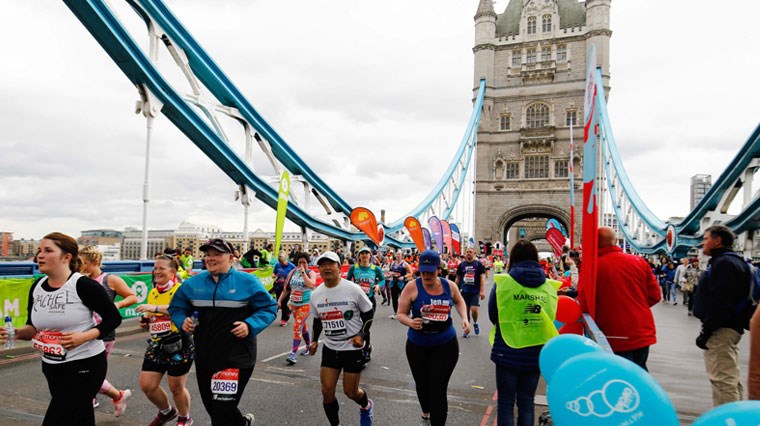
When is the London Marathon?
The London Marathon is typically held on the last Sunday of April, with the mild weather and increased daylight of London’s spring offering ideal running conditions. In 2020 - 2022 the race was held in October due to COVID-19, but it returned to its original date from 2023 onwards. It will be running on the 21st of April, 2024.
About the London Marathon
The first London Marathon was in 1981 and it has grown to be a notable day on the calendar for UK citizens and runners around the world. Inspired by their participation in the New York City Marathon of 1979, former Olympic steeplechase athlete Chris Brasher and John Disley, a Welsh Olympic athlete set out to replicate this event and the unity it represented in London.
Why you’ll love the London Marathon
With a plethora of museums and theatres at your fingertips, and as a cultural hub for everything from fashion to food, traditional pubs to high tea, London has a lot to offer following your marathon.
Historic castles alongside seemingly endless skyscrapers make it an awe-inspiring city, with famous landmarks that are recognisable across the globe – many of which can be spotted on the London Marathon route that has remained relatively unchanged since its origins.
The London Marathon doesn’t always take itself too seriously – receiving a Guinness World Record title for the most runners in costume of any race across the globe – from runners wearing Big Ben to Telephone Box costumes from head-to-toe, to rhino and royalty inspired fancy dress.
For some, it’s purely a day of fun and fundraising – as one of the largest yearly fundraising events in the world. For other runners, setting a PB may be in their sights like Eliud Kipchoge, a 4-time London Marathon winner. Unfortunately, Eliud had to save his return to the London Marathon for another year, withdrawing ahead of the 2022 London Marathon due to a hip injury.
What to expect from the London Marathon course
Beside the famous double-decker tourist buses, exploring London by foot is a favourite way to soak in the sights and breathtaking landmarks. Running around the River Thames, the London Marathon is predominantly flat, allowing runners to sustain a faster pace and sitting around the medium difficulty mark compared to the other 6 major marathons.
This iconic route begins in Greenwich Park in Blackheath, heads over the Tower Bridge with a gradual uphill climb and supportive crowd - putting this London attraction literally under your feet about halfway in. It heads through the Isle of Dogs and Canary Wharf, ending at The Mall, Buckingham Palace. There's famous landmarks along the way, particularly towards the last stretch – like the London Eye, the world’s largest Ferris wheel and Big Ben.
With the magnificent numbers participating in the London Marathon, congestion and flowing into your own rhythm can be an issue. Runners are designated a place at one of the three starting lines - Greenwich Park on Charlton Way (red start), St. John’s Park (green start) and Shooters Hill Road (blue start) - which converge in Woolwich, close to the Royal Artillery Barracks and about 4.5km (3 miles) into the race. Take this opportunity to give a big smile and wave to your fellow runners - after all, you're in this together!
As we touched on, the London Marathon is mostly flat. There's a few gentle uphill climbs during the race, but it's the effects of running downhill that can really catch runners off guard. The downhill slope early in the race can cause you to get your pacing out of whack. It can be deceptive in terms of feeling easier with gravity working in your favour, but setting too quick a pace early on may have the effect of your legs fatiguing earlier than you hoped. Be mindful of pacing and take care knowing that your legs can take a beating running downhill with the increased impact forces acting on them.
Application process
Over 40,000 people participate in the London Marathon. With its escalating popularity, the competition for entry is increasing with each year – with everyone from elite athletes to ambitious runners and charity runners lacing up.
The typical way to gain entrance into the London Marathon is through a ballot system – for most runners, you’re relying on the luck of the draw. This allows runners of all skill levels to be a part of the momentous occasion, reflecting the unity the London Marathon represents.
Charity runners may also be accepted, but places are also limited and require a registration fee that’s paid for by the charity. Your charity will recover the cost from the registration free from the funds you raise – and usually a minimum amount of £2,000 (about $3500 AUD) will be set.
Contact a charity that you’re passionate about – they’ll usually select their charity runners based on why this cause means something to you and on your ability to raise funds. Running for a charity will add an extra spark of motivation to ignite your pace and cross the finish line bursting with pride.
For UK residents, if you are an efficient runner and this isn’t your first marathon, you may be admitted for entry if you have a fast time. This is referred to as a ‘Good For Age’ entry – where you must qualify by achieving a specific marathon time for your age group and gender.
London Marathon: Need-to-know
Keep in mind that the London Marathon is predominantly level, so you may be relieved to know that uphill running isn’t a priority during your marathon training – although it certainly couldn’t hurt to build your cardio fitness and muscle strength.
Depending on the weather of the day, you may be running in warm conditions that could be pleasant when you’re sightseeing, but be challenging when endurance running, especially if the bulk of your training was in cooler weather. Take advantage of the water stations – you’ll be thanking yourself for taking this small delay when that extra hydration will give you the push your performance needs to cut seconds off your PB.
Also, keep in mind that the London Marathon route can be congested with fellow competitors – we are talking thousands upon thousands of runners. If you have a competitive spirit and want to overtake during the first half, weaving between your fellow runners to pave a path through can result in energy wastage and burn you out quicker than you may expect. Instead, be aware that there’ll be plenty of opportunities to overtake during the second half, where the crowd of runners tends to become more dispersed.
Berlin Marathon
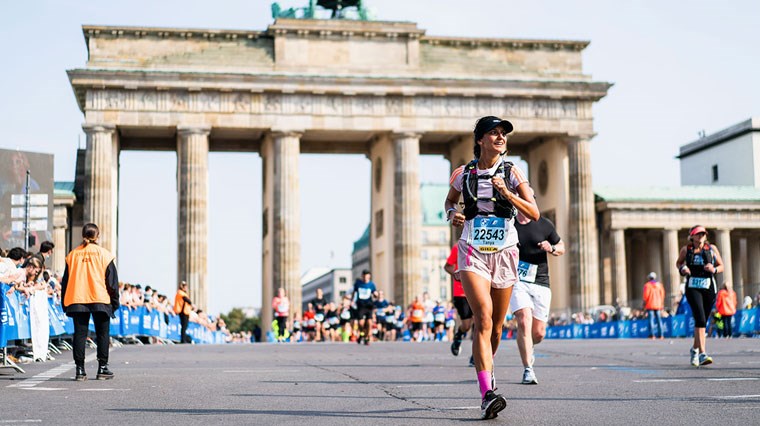
When is the Berlin Marathon?
Last Sunday of September (29th of September, 2024)
About the Berlin Marathon
The Berlin Marathon in Germany is the fastest of the 6 major marathons – an extraordinary and inspiring route where world records are set and broken. On the 25th of September 2022 Eliud Kipchoge set an astounding pace, finishing the marathon in 2:01:09 – cutting 30 seconds off his own world record set four years prior and setting the fastest official time of any marathon in history.
Unofficially, his fastest time conquering the 42.2km distance is 1:59:40 which was set in 2019 on a Vienna course as part of the INEOS 1:59 Challenge. This wasn’t an open competition but nevertheless a limit-defying performance, which you can read about in Nike’s 50th Anniversary: A Celebration Of Sport & Future Sustainability.
Back to Berlin – the Berlin Marathon’s roots are in 1974, when Horse Milde – a baker and runner – set in motion from humble origins a race that would rule them all in terms of the records set on its route. His running passion fuelled what is now a race in its 48th year and an event that includes 34,879 finishes and involves the participation of runners across 157 countries.
Originally the Berlin Marathon course was in West Berlin only. Since the Berlin Marathon of 1990, it has run through East and West Berlin. It was an event of celebration – not only of runners across the globe but of the openness and freedom represented with the Berlin Wall falling a few months prior after a mass protest. The Berlin Wall was a literal and heavily guarded concrete barrier that had segregated West Berlin from East Germany for nearly 30 years – a symbol of the Cold War.
Why you’ll love the Berlin Marathon
The Berlin Marathon is a joy-inspiring celebration – with live music played along the course from jazz to samba creating a party atmosphere that won’t soon be forgotten.
There’s a vibrancy and hope shared by runners and spectators that lifts the tumultuous cloud of Germany’s past in a celebration of unity. Although the crowds may not reach the cacophony of the New York City marathon, the enthusiasm and support of the locals is infectious.
As all runners know, it isn’t purely about putting one foot in front of the other – and running the Berlin Marathon is emotional. Since the fall of the Berlin Wall, the marathon runs through the Brandenburg Gate – a spectacular finish to a historic race.
The Brandenburg Gate is a monument that once represented the division of East and West Germany and was in a restricted area during the heart of the Cold War, but now stands as a symbol of reunification – accessible by all.
It’s an unforgettable, awe-inspiring experience, particularly for the locals but tourists will also be swept away on an emotional ride by the significance and meaning – with a once deserted and dangerous place, being flocked to by people in their thousands to celebrate freedom.
What to expect from the Berlin Marathon course
In terms of the runners’ experience, the Berlin marathon offers a winning formula of traffic-free, runnable roads being wide, level and well-maintained, giving it the reputation as the flattest and fastest marathon course in the 6 major marathons line-up (although the Chicago Marathon is a close contender for this title).
This combined with the cool climate come race day, makes it the most PR-friendly marathon of the 6 major marathons. If you’re seeking to set a qualifying time to be accepted in the Boston Marathon, the Berlin Marathon should be on your radar.
This spectacular route loops through the German capital’s heart, with the starting line and finishing line not far from one another (but of course, you’ll be taking the long way around). It includes breathtaking monuments that are a must-see for all visitors to Berlin - including the Reichstag, the Siegessäule, Berliner Dom, Brandenburg and Potsdamer Platz and of course, the historic Brandenburg Gate.
Application process
The ballot entry process or ‘raffle for runners’ is what makes the Berlin Marathon easily accessible to runners of all abilities, admitting up to 44,000 runners through this process aged 18 and up.
Thanks to this 'marathon lottery' system, no qualifying time is needed to compete in the Berlin Marathon – but you can skip the ballot entry process and register as a fast runner. To do so you must have completed an AIMS (Association for International Marathons and Distance Races) certified marathon and meet the cut off time within your age group. This qualifying time must have been achieved no more than 3 years ago to be considered.
Alternatively, you could apply for a charity place and run the great route with a cause that’s close to you in mind.
Berlin Marathon: Need-to-know
Plenty of refreshment points on the course will offer water, tea and fruit, but do remember to bring your own energy gels and running nutrition, as you may find the brands that you’ve trialled and tested in the months prior will not be readily available in Berlin.
In terms of race day, the mild weather in Berlin in September tends to be just-right for smashing your PB – being pleasantly cool for runners as you shift the pace up a gear. However, don’t let the ideal conditions and extremely flat course with few sharp turns lull you into a sense that it’ll be effortless – a marathon is a marathon after all.
Putting these marathon training tips into action will help prepare you for the journey, because despite the ‘easy’ terrain there will be mental hurdles along the way that you’ll need to persevere through. Like any marathon, the Berlin Marathon is challenging – but that’s what makes it well worth the effort!
Chicago Marathon
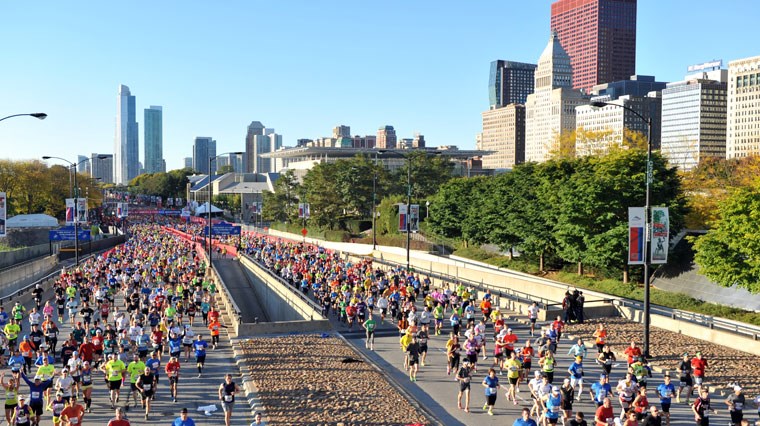
When is the Chicago Marathon?
Held on a Sunday in October (13th of October, 2024)
About the Chicago Marathon
Originally named the Mayor Daley Marathon in honour of deceased Mayor Richard J. Daley, the Chicago Marathon made its debut in 1977 – an event that showcased the running passion of the Windy City with over 4,200 runners participating from the get-go.
The hope was to make Chicago "the running capital of the world' – and at the time it was the largest city marathon on the planet. This ‘marathon fever’ spurred other running events in the city, such as the Chicago Distance Classic (currently known as the Rock 'n Roll Marathon) and by the mid-1980s, the Chicago Marathon had a reputation as 'The World’s Marathon'.
Fast-forward to the 2022 Chicago Marathon and 40,000 runners were on the starting line, running through 29 neighbourhoods and cheered on by over one million spectators. It’s difficult to translate the infectious atmosphere on paper – a vibrant celebration of diversity and culture.
In its current form, it’s officially known as the Bank of America Chicago Marathon. It attracts elite marathons from across the globe, with five world records having been set on its flat course. Kenyan runner Brigid Kosgei’s world record of 2:14:04 was set in Chicago in 2019, cementing her legacy as the fastest female marathon runner to date.
Why you'll love the Chicago Marathon
The Chicago Marathon is pancake-flat – which translates to fast finishing times, so if setting a new PB is in your future, it’s an amazing opportunity to seize feet first. Long, straight stretches of road allow you to flow into a running rhythm and maintain a steady pace without the threat of hills dragging down your energy or momentum (until ‘Mount Roosevelt’ right at the end – but more on this later).
The Chicago Marathon could be the step (or literally, the tens of thousands of steps) you need to set a qualifying place needed to be admitted into the Boston Marathon.
The roads are wide, so you’re not bumping elbows at every turn and the aid stations are long, giving you effective opportunities to hydrate. The crowd – well, they’re electrifying. It’s worth having your name on your running top to hear kind strangers shout it out with support and pride to energise your stride. If you enjoy the benefits of running to music, be sure to keep one ear free of ear buds to soak in the fun-filled vibes and ride the enthusiasm and hype to the finish line.
Save the sight-seeing until the days after your race, but be sure to give yourself time to immerse yourself in the big city – the breathtaking architecture and a plethora of museums from art to natural history and the free Lincoln Park Zoo. Chicago is both home of the world-famous Lake Michigan – one of the largest lakes on the planet which gives the city its coastal vibe, and of iconic sports teams including the Chicago Bulls for the NBA fans out there.
What to expect from the Chicago Marathon course
As we’ve already touched on, the Chicago Marathon is flat in terms of elevation for the majority of the journey, but bouncing in terms of crowd energy. It’s a loop course, kicking off and ending at Grant Park.
The course takes you through iconic monuments and across six Chicago River bridges, offering slight inclines but nothing to baulk at – but that isn’t to say that your legs won’t be turned to jelly due to the sheer distance. You’ll notice carpeted zones on the bridges – look out for them. They’re a kinder surface to run on than slapping your feet on the metal grates, but can be a trip hazard so tread carefully.
It’s a beautiful run – with parks, lakes and rivers providing a natural contrast to the concrete jungle of Chicago. It takes you through 29 neighbourhoods - Lincoln Park, Wrigleyville, Old Town, The Loop, Greektown, Little Italy, Pilsen, Chinatown and Bronzeville to name a few.
Runners that rely on a GPS running watch will find that the city, complete with towering skyscrapers, will block GPS reception – putting your pacing data on the fritz. Let go of technology and listen to your body. Practice pacing during your training without relying on the feedback of a GPS sports watch to get a good feel of what works for you. Alternatively, you can use standard stopwatch features to time your splits manually at the mile marks if you're keen to keep track.
There is one truly notable hill towards the end, as you move from Michigan Avenue onto Roosevelt Road. Affectionately nicknamed ‘Mount Roosevelt’ by runners, it feels like a cruel joke at the time being only about 400m from the finish line, but in reality it’s quite a gentle hill or at least would feel like it on any other day. The challenge comes from where it’s positioned in the race – 41.8 km (26 miles) in at a point where your legs are bound to be screaming for a break and the end is just out of reach. You can and will conquer this seemingly endless hill – then it’s just a slight downhill dash to victory.
Application process
Applications are open to the Chicago Marathon between late October and end of November of each year for the year following. Getting a place in the event through the lottery system can be a gamble, but the odds are better in comparison to the New York Marathon. You’ll usually hear back on whether you’re successful in mid-December.
For a guaranteed place, you can meet a qualifying time specific to your age group in a USA Track and Field certified event. This must occur prior to your application but within the same year. You can also run as part of a charity – combining training goals with fundraising goals for a rewarding experience.
Alternatively, you can run as part of a Bank of America Chicago Marathon International Tour Program – a viable option for runners living outside the United States seeking to skip the lottery for guaranteed entry.
Chicago Marathon: Need-to-know
At first, running to your own beat can be a challenge with the dense sea of runners controlling the pace. That’s OK – resist the urge to forge your own path through. Instead, keep it slow, preserve your energy and soak in the enthusiasm of the spectators. You’ll have opportunities a few miles in to flow into your own stride without having to waste your energy weaving through fellow runners.
Also, avoid the temptation to kick off with a bang. Yes, the flat road encourages a snappier pace and the route is known for being fast – but 42.2km is still long and a test of your endurance. Hold off on running at full pelt to avoid burning out early – even if your motivation is high with the supportive crowd propelling you forward. Remember it's a marathon (literally!), not a sprint.
When it comes to weather, Chicago will keep you on your toes. Previous years have forced runners to endure everything from scorching hot and humid conditions (being cut short in 2007 3.5 hours in due to extreme heat) that put runners at a health risk, to comfortably cool and PB-friendly weather.
Study the location of aid stations to plan your hydration strategy ahead of time – keeping in mind hydration packs are not allowed, but running waistpacks fitted with hydration flasks are. In the past, when the temperature heats up the Chicago fire department has hosed down runners on-the-go with water from their trucks. If the hoses are out, take advantage of this and run through the arc of water. As long as you’re wearing proper running clothing, it should dry fast while the soak down will keep you invigorated and refreshed.
Layering is a smart move – allowing you to maintain your core temperature pre-race to avoid energy wastage and shed a layer as needed per the conditions, especially if wind, chill and rain is expected. Particularly at the start of the race, it’s common practice for runners to discard ‘throwaway’ layers like running gloves and running jackets – but don’t worry, because they won’t go to waste as volunteers collect them to be donated.
Training for running on flats is essential – and surprisingly challenging. Yes, it’s easier in many ways as gravity won’t be working against you as it does when uphill running, but it also means that running forces will be applied consistently and repetitively to your muscles in the same way which can make them feel overworked and overstressed.
New York City Marathon
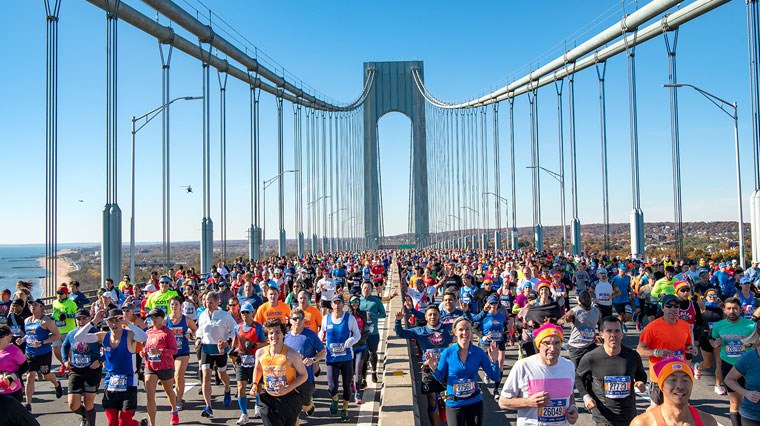
When is the New York City Marathon?
First Sunday of November (3rd of November, 2024)
About the New York City Marathon
You couldn’t have guessed by looking at the New York Marathon of today – the largest and most popular marathon on the planet, but the New York City Marathon had humble beginnings in 1970, spearheaded and organised by the New York Road Runners as it is to this day. The course originally was set solely in Central Park - a 4 lap race that consisted of 127 runners with only 55 finishing.
6 years later, the course was adjusted to run through New York’s five boroughs in celebration of the United States Bicentennial, and runners haven’t looked back. The New York Marathon has grown into a spectacular event which is 50,000 runners strong with over a million spectators. It’s a celebration of diversity – bringing runners of all backgrounds and abilities together in a shared and vibrant experience.
Why you’ll love the New York City Marathon
New York is full of energy and entertainment, being celebrated as the “city that never sleeps” and is the subject of many songs and films. It takes the term ‘city’ literally to new heights, with awe-inspiring skyscrapers that make the term ‘metropolis’ perhaps a better word to describe it.
The course takes you through New York’s five boroughs; Staten Island, Brooklyn, Queens, The Bronx and Manhattan, and includes five famous bridges – essentially a running tour of this diverse and world-famous city.
Due to the nature of the application process, novice runners and elite runners will share a road. No matter where your ability falls, your efforts will be rejoiced by over a million spectators. The crowds are thick with applause and smiles – and if you wear your name or country on your running top, you’ll hear it cheered with enthusiasm from the sidelines. No matter who or where in the pack you are, you feel like a true athlete.
When fatigue, aches and mental hurdles are weighing you down in the latter half of the race, these motivational moments ignite the will to carry on to the finish line. In the New York Marathon, strangers become your fans and having that support to top off your months of training may be the very thing that inspires you.
Many runners have a love/hate relationship with uphill running – and the New York Marathon is the embodiment of that – a gruelling slog and a rewarding challenge in one. When you cross the finish line, you’ll find it was the difficulty, and the building of your mental and physical resilience along the way that made it all worth it.
What to expect from the New York City Marathon course
Alongside the emotional reward and challenges, the route literally has its highs and lows. It’s worth emphasising the highs - crossing several bridges and hills that will push your quads to the brink in a test of stamina and endurance when running turns into an upward climb.
The New York City Marathon begins at Staten Island and crosses the Verrazzano-Narrows Bridge, where your months of training and grit are rewarded with spectacular views of the New York Harbor and Statue of Liberty in the distance.
Whether you're on the upper or lower level of the Verrazzano-Narrows Bridge, the air will be rich with enthusiasm, but be sure to pace yourself during this first 3km to prevent wearing out early – costing you your long-term endurance.
The New York Marathon isn’t shy about getting you climbing bridges from the get-go – which of course means downhills are on the other side as it takes you to Brooklyn which puts smooth, relatively flat roads beneath your feet – giving your legs an opportunity to recover from the uphill journey prior.
The most challenging is the climb across the Queensboro Bridge into Manhattan, 22.6km (14 miles) in – and of course, there is still a long stretch of road to conquer at this halfway point. Those stunning views have a price – taking their toll on your quads, plus the bridge has no spectators which can be daunting when you rely on that boost of enthusiasm to spark motivation beneath your feet. Use this moment of silence (beside the sounds of your fellow runners putting foot to pavement) to be proud of how far you’ve come and reflect on where you’re going – with your ultimate goal within reach.
Fast-forwarding to the last 10K, a combination of flat stretches and gruelling uphill climbs will challenge you, including when you run through Central Park about 38.6km (24 miles) in. Listen to your body, but also listen to the rejoicing crowd and roaring music in the distance to motivate you during the final stretch.
Application process
Runners of all abilities can enter the ‘marathon lottery’ for the New York City Marathon, however you can’t bet on it to secure a place as you’ll be competing against hopeful runners in the thousands. Alternatively, partner with a charity participating on the day to lock in your slot – running to raise funds and awareness of a worthwhile cause.
To secure a guaranteed place in the New York City Marathon, you can set a qualifying time in a certified half or full marathon, particularly in an event held by the New York Road Runners (NYRR) as these runners are prioritised. Qualifying times that aren’t set in a NYRR race follow the idiom of “early bird gets the worm” and openings are limited. If you miss out, your entry will join the thousands of others in the drawing process.
Alternatively, the International Travel Partners program makes the race more accessible to international tourists, purchasing a ‘Travel Package’ that includes entrances into the New York City Marathon and flights and/or accommodation in New York City. However, even then, you may be put on a waiting list so it may take both patience and persistence to get to the point where you’re lacing up for New York.
New York City Marathon: Need-to-know
The temperature at New York this time of year can be described as ‘goosebump weather’ – it’s cold. Keep in mind that particularly on the bridges you’ll be exposed to the elements, and potentially considerable winds. Wearing a lightweight, weatherproof and packable running jacket will help you dress for the conditions. You may also notice donation bins for clothing at the Start Village in Staten Island if you need to strip down a layer prior to the race.
Note that running hydration vests aren’t allowed – so if you want to carry energy gels or hydration, a small marathon running waistpack is the way to go, although the water stations are adequate for most runners if you prefer to rely on them to carry less weight.
The bridges and hills will challenge you – and you may be tempted to go full speed on the flat stretches, but this time is best used to recover and preserve your energy for when it’s in the highest demand on the hills. Needless to stay, hill training should be a priority during the months leading up to your New York City Marathon.
If you’re sightseeing in the days prior to the race, don’t try to cram everything in or risk wearing yourself out – there’s so much to see in New York from art museums to towering monuments - it can be exhausting! Save that energy for your big race. Enjoy a Broadway show rather than relying on your legs to take you on a walking tour as race day approaches.
Happy marathon training, chase those medals and we’ll see you on the road!
Hunting for your go-to marathon shoe? For an in-depth shoe fitting experience, you can book a free 15 minute video chat in a Live Fit session or make an appointment to discover your RunDNA at Sportitude Running@Hindmarsh or Sportitude@Fullarton.
Book your RunDNA assessment today!
If you liked this, you’ll love:
15 Performance, Nutrition & Recovery Essentials To Survive Marathon Training
12 (Half) Marathon Training Tips For Beginners
Jessica Stenson On Goal Setting & Marathon Training As A Mum
